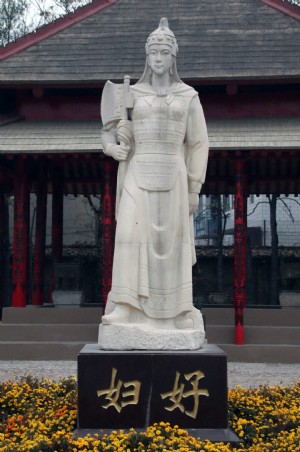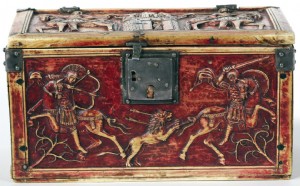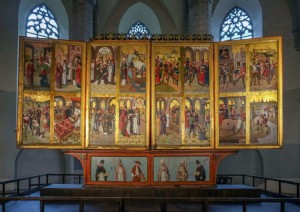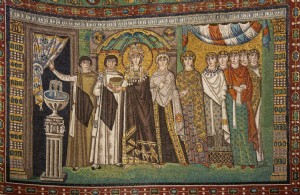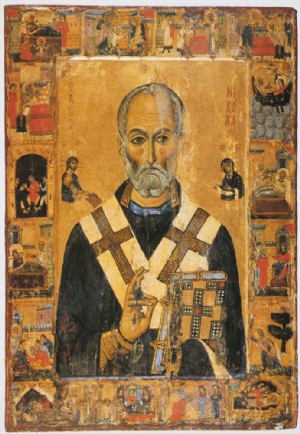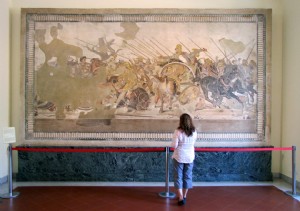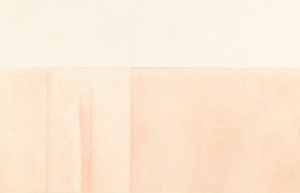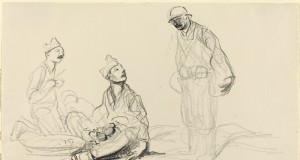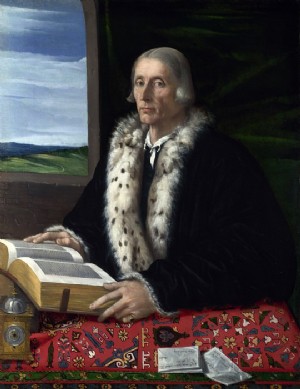彼らの時代を先取りしていた多くの天才のように、 アンリ・ルソーは彼の人生の間に知りませんでした、 名声も富もありません。才能のあるアーティスト、 パリ税関の普通の店員として41歳まで働いていた人、 彼の通常の生き方をあきらめ、完全に絵画に専念する意志を見つけました。趣味でルソーを支えたのは、彼自身の才能に対する揺るぎない信念だけでした。 それは彼が彼の時代の最も偉大なマスターの一人になることを可能にしました。驚いたことに、 過去の技術を模倣したいという願望は、アーティストを直接未来に移しました-彼の創造的な方法は、20世紀の多くの巨匠の非常に特徴的なものになるでしょう。ルッソの「ナイーブ」アート、 印象派と歩調を合わせて、 すぐに完全に別の学校に分かれました。画家のオリジナルスタイル、 ファンタスマゴリーの要素でいっぱい、 パブロ・ピカソとロベール・ドローネーに賞賛され、 ルソー自身に彼の人生の間に最小限の生存手段だけを与えました。
嵐の青春
41歳でアーティストとしてのキャリアをスタートさせ、 アンリ・ルッソは独学でした。パリの地方から到着し、ささいな役人として定住し、 ルソーはいたるところに描いた:勤務中、 上司の好意を利用して、 そして夜は家で。貧しい、 しかし、忍耐強く、 控えめ、 しかし、彼の天才に自信を持って、 彼は芸術的前衛の第一人者で最も有名な巨匠の一人になりました。 これは、進歩的な同時代の人々や何世代にもわたる子孫に賞賛されていました。
ルソー自身が「次の世紀の肖像」という本に自伝的なメモを書いたことがあります。 彼は間違った職業に専念することを余儀なくされました、 それが彼を芸術への愛に惹きつけました。」 NS、 その本は決して出てこなかった。
独学の芸術家の父は、ジュリアン・ルッソ(フランス西部の町の遺伝的な鋳物職人)であるラバルでした。そして彼の母親はナポレオンの大軍の将校の娘です。アンリの父親は必死に金持ちになりたかった、 したがって、 街の郊外で家を買ったので、 彼は自分の工芸品を鋳物職人として残し、さまざまな商品を再販するビジネスを確立しようとしています。しかし、 悲しいかな、 彼の仕事は燃え尽きて、 それ以来、絶望的な貧困がルッソの家に落ち着きました。
幸運にも、 極端な必要性にもかかわらず、 未来の芸術家の家族は彼女の一人息子を学校で最初に勉強するために送ることができました、 そしてリュケイオンで。アンリは平均的な学生でした、 彼は何とか多くの学校賞を受賞しましたが、 歌と算数で自分を際立たせます。これらの一見取るに足らない業績は、ルソーが世界的に有名な芸術家になったからではなく、彼の伝記のいたるところに記されています。 しかし、彼は最初の妻にちなんで名付けられた素晴らしいワルツ「クレマンス」も書いたからです。
トレーニングの後、 ヘンリーは法律事務所に就職し、 彼が大きな間違いを犯したところ。 19歳の時、 彼の友人によって扇動されて、 ルソーは経理部からわずかな金額を盗み、 しかし、これは彼の弁護士のキャリアに終止符を打ち、調査を受けるのに十分です。法廷で、 ヘンリーは契約に同意する必要があります-7年もの兵役、 刑務所でたった1年。
ルッソ連隊、 フランスに駐在、 海外での敵対行為には決して参加しません。ナポレオン3世が、皇位争いで彼の弟子マクシミリアンを支援するためにフランス軍団をメキシコに派遣したときでさえ、 将来の前衛は遠征に参加しません。それでも、 かなり後に、 詩人ギヨームアポリネール(1880〜 1918年)は、ルソーがカラフルなアステカの国に滞在したことについて詩を書いています。 アーティストは決してそれを論駁しようとはしません、 彼の人生についての他の多くの神話と同様に。
1868年、 ルソーの父が亡くなり、 とヘンリー、 家族の唯一の稼ぎ手として、 軍から解雇されます。彼の連隊を去った後、 その後、パリにありました。 彼は大都会の忙しい生活に真っ向から突入します。初めに、 若い男は仕事を見つけて人生を歩みます、 ボンマルシェ百貨店からそう遠くない場所にあり、 フランスの首都で最初の高層ショッピングセンター。
若い男はすぐに家の愛人の娘と恋に落ちます、 マダムブアタール。 1869年、 彼はクレマンスブアタールを妻として連れて行きます。絶え間ない衰弱にもかかわらず(クレマンスは結核で病気でした)、 配偶者はアンリが一生お金を稼ぐのを手伝います、 注文に応じて精力的に縫製を行っています。毎週末に、 愛好家はしばしば美しいパリの公園を散歩します。 NS、 アンリとクレマンスの幸せは、彼らの子供たちが幼児期に次々と死ぬという事実によって影が薄くなっています。
愛する配偶者の7人の子供のうち、 生き残るのは、ジュリー・クレマンスの娘とアンリ・アナトールの息子の2人だけです。ルッソの妻、 結核に絶えず苦しめられている、 弱すぎて子供たちの世話をすることができませんでした、 それで、彼らは生まれてからパリ郊外に住んでいた乳母によって育てられました。 1888年、 クレマンスは死ぬ。アンリ・ルッソは彼の最愛の妻を決して忘れません。彼女の一生の間でさえ、 彼は彼女に彼自身の作曲のワルツを捧げるでしょう、 そして彼女の死後、彼は何度も何度も彼女の肖像画を作成します。
1871年に戻って、 若いルッソは物品税局の税関で正社員になりました。 19世紀にパリに輸入された商品から税金を徴収しました。城門での商品の検査は退屈で単調な仕事ですが、 しかし、それはそれを実行する人の内なる自由を制限するものではありません。
次のシフトの1つで、 小さな店員が部門ビルの中庭にイーゼルを設置し、 描き始めます。不幸にも、 1877年までルッソが描いた絵画は生き残れませんでした。例外は1つだけです。 地元の風景を背景にした戦闘シーンを描いています。
後で、 当時有名な芸術家フェリックスクレメント(1826年-1888年)、 若いルッソのアドバイスを手伝った人、 その時代の公式フランス芸術の代表者の一人に意欲的な画家を紹介し、 レオンジェローム男爵。その後、 ルソーは彼の最初のワークショップを借り、1885年に 男爵に支えられて、 レミゼラブルのサロンで彼の作品の2つを最初に展示しました。
一年後、 1886年、 アーティストのポール・シニャック(1863-1935)、 アンリ・ルッソの作品に興味を持って、 彼を新しい展示会に招待します。シニャックは、そのようなオリジナルの画家の作品に最適な場所は、独立した芸術家のサロンであると考えました、 前衛芸術の代表者によって作成されました。事実は、独立したサロンを作成するためのすべての初期の試みは失敗に終わったということです-まるで魔法のように、 彼らは公式のサロンに似始めました、 個別に展示する必要性が高まっていると感じた進歩的な画家には適していませんでした。
ルソーの場合、 サロンに代表される公式アートサークルは、 その古い学術的伝統で、 独学で永遠に拒絶していただろう、 少なくとも原則から。したがって、 その時から最後まで、 アンリ・ルッソは、新しい「陪審員のいないサロン」に忠実であり続けます。
すでに1886年に、 彼の作品のうち4つを独立したサロンで展示した後、 意欲的な芸術家は、ポール・ゴーギャン(1848年-1903年)やピュヴィ・ド・シャヴァンヌ(1824年-1898年)などの有名な画家に高く評価されます。 多くの黒の色合いの助けを借りて劇的な瞬間を伝えるルソーの能力に喜んでいた人たち。しかし、 一般に、 彼の作品は一般の人々には理解できないままですが、 さらにそうです-彼らは嘲笑されています-学者たちは子供でさえそのように描くことができると主張しました。
幸運にも、 ルソーは、皮肉や国民の批判に対して非常に抵抗力がありました。彼はアーガスとの合意さえ締結します、 それによると、すべてのジャーナル記事と新聞の切り抜きが彼に送られました、 彼の作品に対するレビューとコメントが含まれていました。彼の議論の余地のない才能の普遍的な認識を見越して、 アーティストはそれらをノートにペダントに貼り付け、 やがて厚くなりました。パリ市庁舎が彼にメダルを授与したことをルッソがかつて知ったのは新聞からです。幸せ、 彼はすぐに彼の名刺に賞を記載するように命じました、 しかし後で、彼は急いでいたことがわかりました。それは同じ名前の別のアーティストについてでした。
妻の死後、子供たちの通常の維持のための資金を見つけ、塗料を購入することを懸念して、 ルソー、 お金を稼ぎ、1889年にパリで開催された世界博覧会に感銘を受けることを期待して、 フランスが彼女の有名なエッフェル塔を提示した場所、 アーティストは再び音楽に目を向け、寄席の台本を書きます。不幸にも、 それは一銭ももたらさなかった。
1893年に退役した後、 長年の奉仕の後、 ルソーはわずかな年金を受け取り、彼の好きな娯楽である絵画、 ついにまともな収入をもたらし始めます。その間、 ルッソはバイオリンのレッスンをし、注文に応じて絵を描くことを余儀なくされています、 ばかげた価格でそれらを販売します。それでも、 ちょうど一年後、 彼の作品「戦争」、 インディペンデントサロンに出展、 幅広い反応を得る、 特に、 作家のアルフレッド・ジャリー(1873-1907)は彼女を賞賛し、 その光で、 アーティストのアンリ・ルソーは「税関職員」(ル・ドゥアニエ)というニックネームを受け取り、 一生彼に固定されました。
後で、 ルッソ一家全員が引っ越し、 誰がどこにいますか。 1895年、 アーティストの娘は夫と一緒にアンジェに出発します。 フランスの西に位置し、 画家は息子のアンリ・アナトールと一緒に、セーヌ川の左岸にある有名なモンパルナスに住むために移動します。 後に芸術的で知的前衛的な人々のお気に入りの待ち合わせ場所になりました。三、 モンパルナスで、 ルソーは、アーティストの心をつかんだ近所に住んでいた女性、ジョセフィン・ル・テンソルと出会う。長い間、 ジョセフィンは画家の愛の告白を無視し、アンリアナトールの早すぎる死の後にのみ彼の妻になることに同意しました。
自由を愛するフリーメーソンとして、 アンリ・ルッソは1898年に彼の新しい愛をもって教会でまだ結婚していました。家族の経済状況はかなり悲惨でした、 したがって、 彼女の夫を助けるために、 ジョセフィンは自分の作品を事務用品店で売ろうとしましたが、 とアーティスト、 順番に、 有料レッスンを続けました。それにもかかわらず、 日曜日に、 ルソー、 彼の必要性にもかかわらず、 哲学協会の枠組みの中で、 その主な目標は大衆を教育することでした、 水彩で描きたいと思っているすべての人に教えました、 パステル、 そしてまた、 誇りと喜びをもって、 磁器と陶器の絵画での彼の経験を共有しました。
ちょうど5年後、 1903年、 画家は二度目の男やもめになり、 と、 悲しみに対処しようとして、 彼は完全に仕事に専念している。私は言わなければならない、 アーティストとしての彼のキャリア、 ようやく勢いを増し始めました。 1903年、 彼は再び2つのアートサロンに参加しました-インディーズアーティスト(3月)と最初のオータムサロン、 10月にオープンしました。しかし、画家はまだ切実に必要とされています。幸運にも、 控えめだが寛大なパプア人の家族、 近所に住んでいた人、 しばしば彼を彼らの夕食に招待しました、 と友人のマリービッシュ、 小規模貿易に従事している人、 重大な財政状況でルッソを何度も助けます。
ターニングポイントは1906年にのみ発生します。 アーティストがロベール・ドローネー(1885年-1941年)と詩人ギヨーム・アポリネールに会ったとき。新しい友達は画家の才能を公然と賞賛し、 およびパブロ・ピカソ(1881–1973)、 1908年にブリスアンリルッソによって誤って女性の肖像画を取得した、 著者に敬意を表して壮大な宴会を開催します。
ピカソの友達の一人、 フェルナンダオリヴィエ、 ルソーは次のように述べています。 歩くよりジョギングする可能性が高い少しかがんだ男、 彼の髪は灰色ですが太いです 彼の年齢にもかかわらず、 小さな借家人の習慣があります、 彼の顔は少し怖いです、 でも親切。彼は恥ずかしいときや誰かが彼に反対したとき、簡単に顔を赤らめた。彼は彼に言われたすべてに同意しました、 しかし、彼は身をかがめて、自分の考えをあえて表現しなかったと感じました。 」
ルソーの友人の中には、アルフレッドジャリー(1873年-1907年)がいました。 アーティストは、最後の作品である「ウブ王」(1896年)のときに彼に会いました。 それは彼を不条理演劇の有名な創設者にしました、 まだ書かれていません。おそらく、ルソーとジャリーを結びつけるのは、まさに衝撃と挑発への情熱です。若い作家によると、 税関職員の素朴派、 率直で妥協のない、 平均的な男に衝撃を与えます。一度、 ザリは画家に彼の肖像画を命じた。絵、 不幸にも、 私たちの時代に達していない、 しかし、ルッソは彼の友人をカメレオンとフクロウで描いたことが知られています。フライは大喜びでした!彼は親の相続財産からルソーのお金を支払い、どこでも彼の才能を賞賛します。アーティストはこの友情を大切にしていました。 1897年に運が彼を変えたとき、救いの手を差し伸べ、若い奇行者を保護したのは彼でした。 とザリー、 彼のポケットに無一文、 通りに行き着きました。
アンリ・ルソーは明確な、 幼稚な声、 誰もが彼を素朴でシンプルだと考えていましたが、 でも本当にそうだったの?彼自身の天才への揺るぎない自信は、画家が並外れたスタミナを持つ目的のある人になることを可能にしました、 そしてほとんど幼稚な素朴さ-非常に独創的なアーティスト。
1907年12月、 ルソー、 彼の不注意とだまされやすさのために、 再び詐欺のために刑務所に行きました、 でも、 実際には、 彼は彼の犠牲者でした。自由を得るために、 日曜日に慈善レッスンを行うだけなら、 アーティストは裁判所に請願書を書きます。 仕事を続けるためには、少なくとも条件付きリリースをお願いします。私のキャリアを破壊しないようにお願いします、 私は一生懸命働いた。 " 幸運にも、 ルソーの要求は、クリスマス休暇の後に承認されました。
同時代人によると、 ルソーは通常、シンプルなリネンの白いシャツで働いていましたが、 しかし、彼が彼のワークショップでレセプションを組織したとき、いつもスーツを着ます。ドイツのコレクター、ウィルヘルム・ウグデ、 1911年に本全体をアーティストに捧げた最初の人物。 税関職員の常連の一人でした。ルソーの家があった通りについて、彼は次のように説明しています。私たちはパリではなく、州のどこかにいるようです。 1階の部屋では、オーナーは家族と一緒に住んでいます。 以上がゲストのアパートです。ドアの1つに、「レトリックからの教訓、 音楽、 お絵かき、 ソルフェージュ」。私たちは電話して入ります:ルッソは私たちに会います。 」
ほぼ毎週土曜日の夜、 彼の絵画や友人の間で、 税関職員は芸術家のためにバイオリンを弾きます、 コレクターとただのアート愛好家。彼は再び恋をしている、 でもレオニア、 59歳の未亡人、 彼の妻になることを拒否します。これらの夜には、ルソーが住んでいた家の所有者であるケヴァル氏に会うことがよくありました。 パリの税関で働くルッソの同僚だった静かで立派な男。ゲストの間では、アンブロワーズ・ヴォラードを見ることができました。 アーティストの絵画を購入し、彼と一緒に何度も芸術パーティーに招待した。アンリ・ルソーは感情的な盛り上がりを見せていました。ついに、長年の努力の成果を味わう時が来ました。安定した財政状況です。 普遍的な認識。それはただの健康です…画家は長い間彼の足の治癒されていない傷に悩まされてきました、 どれの、 最終的には、 壊疽を引き起こした。
優秀なアーティスト、 アンリ・ルッソは9月2日に亡くなりました。 1910年、パリのネッカー市立病院で。彼は共同墓地に埋葬された。ロベール・ドローネー、 アンブロワーズ・ヴォラードとポール・シニャックは、最後の旅でアーティストに会いに来ました。
一年後、 ドローネは、自己負担で芸術家の遺骨の返還を組織します。そしてギヨーム・アポリネールは彼の墓石に彼が作曲した碑文を書きます。 私たちの親友ルッソ!私たちの言うことを聞いてください-ドローネと彼の妻、 ケヴァルと私。ブラシをお届けします、 塗料、 そしてプレゼントとしての帆布、 聖なる余暇に星の肖像画を描くように。 」
アンリ・ルッソの最初の絵を覗き込んで、 批評家の一人は、「彼は誠実で素朴で、 原始的なものをいくらか思い出させます。」2番目の批評家は同意します:「この絵はかなり乾燥していてタフです、 でもとても面白いです その素朴さがイタリアのプリミティビストの考えにつながるからです。」ルソーのオリジナル作品の嘲笑者や熱心な反対者でさえ、マスターを優れたプリミティビストとして認めました。
帆布は「森の中を歩く」と「森で会う」ですが、 画家は、イタリアの原始的なものよりも、18世紀のロココ時代の国の絵画にまだ近いです。これは主に、勇敢なシーン(雅宴)のはっきりと見える伝統的なモチーフによるものです。 フランスの芸術家アントワーヌ・ヴァトー(1684-1721)の非常に特徴的な、 その絵画はルーヴル美術館に展示されていました。ところで、 ルッソの工房の壁を飾ったのは彼らの複製でした。
ルソーの初期の作品は、彼を同時代の印象派と非常に区別していました。これは、「森の中を歩く」と「森の中を歩く」の絵画の洗練された配色ではっきりと見ることができます。 画家は、茶色と緑色のさまざまな色合いを使用して、実際の木と想像上の木を描きます。
最初の写真では、 森は密集していて通行できません。 第二に-軽くて透明。すべての長期計画は漠然と作られています、 小さなストローク、 視覚を促進し、 飽和しすぎた暗い森を中和します。空、 写真の3分の1を占める、 故意に遠くの木を減らした-これはすべてアーティストの試みを物語っている-どういうわけか空間の境界を決定するために独学で、 深みを与える、 あれは、 ルソーにとって、 学問的な知識とスキルを奪われ、 本当のつまずきでした。おそらくそれが理由です、 後で彼は故意に彼のキャンバスの見通しを放棄しました。
「森の中での出会い」の絵は、恋人たちが馬に乗ってお互いを見つめている様子を描いています。彼らは18世紀の典型的な衣装を着ています。女性の長い髪は肩越しに自由に緩んでいます。これは、ルソーのブラシの多くの女性の画像に見られるモチーフです。気持ちの強さ、 相互抱擁、 男性の見た目の優しさは、このカップルがキャンバスにいることの明確な効果を生み出します。 彼らの体は緑豊かな植生の後ろに事実上見えないという事実にもかかわらず。自分の世界だけを愛し、 彼らは森の後ろから少しの間現れました、 そして、彼らは再び永遠に視界から消えようとしていたようでした。
「森の中を歩く」というキャンバスには、クレマンスによく似た女性が見えます。 彼女は凍りついたようだった—恐らく彼女は騎兵隊の急いでいるエコーに怯えていた、 葉の驚くべきざわめきや枝の突然のクランチ。
女性の画像、 動物の画像だけでなく、 アーティストの作品の中で大きな場所を占めていました。 2つの大きな女性の肖像画、 小さな隙間を空けてルソーが描いた、 非常によく似た構成です。どちらも、全身を黒く立っている女性を描いています。作品のフォーマットとキャラクターのポーズは、絵画をパレードの肖像画のジャンルに帰することを可能にします。おそらく両方ともオーダーメイドでしたが、 モデルの正体は不明のままでしたが。
最初の帆布「女性の肖像」(別名「M夫人の肖像」)は1895年頃に作成されました。この絵は、1908年に別の優秀な芸術家であるパブロピカソ(1881年)によって非常に手頃な価格で購入されました。 -1973)、 とても熱心だった人。この作品は、ヤドヴィガとしても知られています。 モデル名が一致するという証拠はありませんが。
キャンバス上の女の子が画家を魅了した美しいポーランドの女性だったという伝説があります。このバージョンには証拠がありませんが、 事実は残っています:ルソーはこの名前が好きでした。彼自身が彼らを彼自身の作曲の戯曲の主人公である「ロシアの孤児の復讐」と呼んだ。おそらく、理想的な女性の特定のイメージをアーティストのために具現化したのは彼女でした。同じ名前で、 マスターは彼の他のキャンバスのヒロインを「ドリーム」(1910)と呼びます。
最初の肖像画の構図は、当時の店の舞台写真に似ています。巨大なカーテンに花瓶がいっぱいのバルコニーに立つ女性像、 幻想的な風景に囲まれています。ヤドヴィガの手には木の枝があります。この詳細は、それが伝統的な死の象徴であるという点で特に興味深いものです。これは説明することができます、 この女性の実在の理論の支持者を信じるなら、 キャンバスを書いている時点で、ヤドヴィガはすでに死んでいたと主張する人たち。この仮定は、アーティストが女性のドレスに黒い色を選んだという事実によって間接的に確認されています。 描かれたシーンの特別な劇的な性質を常に強調していました。
2番目の肖像画の女性は、刺激的な多様な緑の中に描かれています。彼女の手は彼女の太ももにかかっています、 そして彼女のドレスの下から覗く彼女の足はほとんど地面に触れません、 動きの錯覚を生み出します。キャンバスの下部に、子猫が糸の玉で遊んでいるのが見えます。 肖像画の公式なトーンに活気と自発性をもたらします。
ルッソは彼の有名な作品「眠るジプシー」を終えます、 女性像にも捧げる、 彼の一人息子の死からわずか1か月後、 アンリアナトール。
1897年、 彼はインディペンデントのサロンで作品を展示しました、 フレームに書かれた伝説を伴う:「捕食者、 血への渇きに圧倒され、 その場でフリーズし、 眠そうな犠牲者をあえて攻撃しないでください。」スカーフとカラフルな服を着たジプシーの姿、 暗い顔色とはっきりと対照的、 アカデミックアーティストの絵画から、オリエンタルな女性を少し思い出させます。ルッソが故郷のラヴァルの対策を取得することを積極的に提案したのはこの作品でした。 自分を偲んで。
アーティストは市長に「ここではすべてが月明かりに照らされている」と書いています。もちろん、 市役所は彼の申し出を拒否した。作品は消え、1923年にのみ再発見され、そして、 ルソーの絵画のすべてが広く知られているわけではないので、 多くの論争と噂を引き起こします。かなりの数がそれを偽物だと考えています、 ジョーク、 これは別のアーティスト、ドランによるものです。絵の真の作者を疑わなかった人は、 それは、画家によるリアリズムからシュールレアリズムへの非常に決定的なステップであると考えました。
後で、 ルソーは印象派から出発し、 彼はまだ伝統的な美術の規範に対する彼らの嫌悪感を共有していましたが。印象派は、ルソーにとって非常に必要な創造的自由を暗示していました。彼の芸術、 すべての形式の完全にフラットな解釈に基づいて、 ルネッサンスで採用された視点を描くための標準的なルールを考慮に入れていないだけでなく、 しかし、意識的にそれらを無視します。アーティストはフォームを簡素化し、 creating his own unique style of painting. The real proportions are distorted here, the color elaboration of the volume is absent, and the shadow does not exist at all. Rousseau did not want to portray boring and mundane reality, passing through his rich imagination all images and forms.
The artist’s art strongly resembles decorative painted pictures with multi-colored figures of smooth texture and unpretentious shape. His painting "The Child with the Puppet" makes a strange impression that makes one shudder. The master first delineates the contours of the figure of a child resembling a porcelain doll, leaving it itself unwritten, then works on the background of the picture and returns to the figure again. Rousseau, like Emil Bernard (1868 - 1941) and Paul Gauguin, completely ignores the principles of classical perspective.加えて、 the painter gives a clear preference to substantive conventions, rather than boring specifics.
Brushes Russo own many children’s portraits. It is not known why the theme of children was so important for the artist, if they were custom-made works, if the artist felt the loss of his six children. The exact answer to this question is unknown, we can only assume that, portraying children, the painter tried with the help of paints, brushes and imagination to bring back to life the images of his loved ones. Many of Rousseau’s portraits of children are in large format.
例えば、 a child in a red dress looks so large that it feels as if his figure hardly fits on the canvas. Apparently, the child is sitting:legs bent at the knees and almost hidden in the grass speak about this. The figure itself seemed to hover between heaven and earth, which imperceptibly smoothes the feeling of excessive massiveness. Like “The Child with the Puppet, ” the kid in this picture also holds a strange doll in his hand, resembling an adult with facial features.
In another picture of the same period - “Peasant Wedding”, we see a bride who looks at us with humble reverence. The figures of the people around her are so flat that they seem to be separately cut out of colored paper and glued to the background landscape. Even in spite of the trees carefully arranged by the letter “V” and some awkward dog located in the foreground, which theoretically should have been a compositional designation of the perspective, they could not erase the collage impression made by this painting.
The bride’s figure is the undisputed dominant of the picture, it is she who, with her snow-white belt, seems to connect the remaining characters into a single group. On the canvas, the artist symbolically indicated the continuity of generations, with the help of a long veil of the bride, slightly covering the elderly woman sitting nearby, who is obviously the grandmother of the bride or groom. The figure of an old man sitting separately from the group of main characters, whose legs are hidden in the grass, conjures up thoughts about the connection between modernity and eternity, life and death, earth and sky. The solemnity with which the whole group is located under the trees again reminds of a 19th century shop. It was in such static poses that people froze in front of a photo lens against the background of painted flat scenery:“We don’t move! Do not breathe! ". It’s possible that while working on the “Wedding”, the painter drew inspiration from some photograph, but nothing is known about the reasons for his appeal to this topic, as well as about the personalities of the prototypes of the characters. Although the man standing to the right of the bride remotely resembles the artist himself.
In 1906, Henri Rousseau presented to the public his new work - “Freedom, calling for painters to participate in the 22nd exhibition of Independent Artists”, どれの、 even being in the exhibition of the Salon of Independents, causes visitors to laugh only. Only a close circle of friends admires the new work of the artist, while the rest can not understand either the design itself or the ways of its implementation.
Friend of the painter - Robber Delaunay exclaims:“In another era, he would have painted the walls of the palaces by order of patrons. In ours, he is forced to be a jester for the inhabitants, he is so serious, so calm. What a senseless irony of fate! ” Russo celebrates the Salon with his new work, which made him a full-fledged artist, in every sense of the word. The compositional center of work is the allegorical figure of Liberty, depicted in a manner reminiscent of the academic. She plays the trumpet, traditionally a symbol of worship.
A year later, Rousseau again amuses the audience in the Salon of Independents with his work “Foreign representatives arrived under the banner of peace to salute the Republic”. On the canvas, we recognize the six presidents of the French Republic (dressed in black) standing on the podium, the Russian emperor (in a yellow and blue uniform), the king of England (on the left side), and also on the right:Franz Joseph from Austria, Peter I from Serbia, William II from Germany, Leopold II from Belgium, George I from Greece, the Persian Shah and King of Ethiopia. The republic, in red robes and a Phrygian cap (the headdress of the era of the French Revolution of 1789) triumphantly rises above all, holding an olive branch in outstretched hand. This multicolored extravaganza, colored by foreign flags, passes under the slogan written on three black pedestals standing in the foreground of the canvas:“Work, freedom, equality. ” And in the background we see people gathering in a circle to start their holiday dance.
The artist was very fond of allegories, so popular among representatives of political circles. Repeatedly Rousseau took part in various competitions, which from time to time are arranged by the Paris authorities in order to decorate the premises of various departments. The painter always wanted to receive an official order, well paid and prestigious, because, まず、 he constantly felt the need for money, と、 第二に、 he still dreamed of universal recognition.
しかし、 the Customs Officer has failed to conquer either one or the other.加えて、 all the time there were people who used this artist’s weakness and his inherent naivety to repeatedly play poor Rousseau. It even came to the point that the painter almost went to the Champs Elysees to personally thank the President of the French Republic for awarding him with his main state award - the Order of the Legion of Honor, the award of which was announced to the artist by evil jokers.
Once, the mother of the artist Robert Delaunay, succumbing to the entreaties of her son, decided to order a Russo painting. Her stories about an exotic trip to India inspired the Customs Officer to create a canvas designed in rich green tones typical of the tropical jungle. In the center of the picture we see the figure of a black-haired woman - a snake charmer, who is very reminiscent of an ancient mystical deity. Black snakes, as if mesmerized by the magical sounds of her pipes, slowly creep out from everywhere, and if at first glance they are barely distinguishable, then when the look gets used to a variegated variety and begins to distinguish details, you see them more and more. Amazingly, their movement on the canvas is felt almost physically. The eyes of the female figure, which are the only bright spot in the picture, add a mystical shade to the canvas, their tremendous attractive power is striking.
A river illuminated by a full moon, a thick and mysterious veil of plants shimmering in all shades of green, an exotic pink bird, brightly shining yellow flowers - the whole scene exudes incredible paradise and tranquility. The vertical lines of the figure and the plants surrounding it are softened by horizontal rays of light coming from the month. This fundamentally distinguishes the composition of “The Enchantress” of Rousseau from his “War”, where the horizontal construction of the entire canvas creates the effect of decay and symbolizes destruction and destruction.
Unpleasant Surprise is somewhat close to Snake Charmer. In this picture we see a woman scared by a bear. The figure of the woman again resembles the mythical goddess, or Old Testament Eve, lost in the Garden of Eden. Her round hips are slightly covered by hair falling down to her knees. As in The Caster, the woman is surrounded by the same bizarre trees with bright foliage, and in the background - on the shores of a magical lake, depicting dense forests of bizarre trees. And in the depths, the figure of a lurking hunter is hardly noticeable. When you see her, the soul becomes calm - he will certainly shoot and save the woman from the predator.
Contemporaries will write down a statement by an Italian critic dedicated to Rousseau:“He lives in a strange world, fantastic and real at the same time, close and far, sometimes funny, sometimes tragic. He loves a riot of colors, fruits and flowers, wild animals and fabulous birds.彼は住んでいる、 working unconscious, focused and patient, met with ridicule and unfriendly shouts every time he decides to break his loneliness in order to present his creation to the world. ”
The hero of the picture “Chaise of Father Juniet” (1908) is a real character - a seller of vegetables, a former friend of Rousseau (though his real name was Claude Junier). His shop on Montparnasse was located just a few meters from the painter’s workshop. Junier always helped an artist who often lacks money for products. Sometimes Junier, along with his friends, took Rousseau to ride on his chaise, which served him for the transport of goods. Juniera’s pet - a mare Rosa pulled a chaise. The seller of vegetables had a great weakness for horses and dogs, one of which is shown in the picture next to the chaise.
When creating the canvas, the artist used a photograph taken in Klamar in 1908. Rousseau transferred the composition of the photograph to the canvas, adding to it a dog on the road and several figures. While the painter was working on the painting, his workshop was visited by the American artist Max Weber (1881-1961). Considering the work, Weber drew the author’s attention to the imbalance in size between dogs and other objects and characters. Rousseau replied:"Everything must remain as it is."
Perhaps the artist is right, relying only on his own vision, because when you look at this work for a long time, it starts to seem that it is this absolutely disproportionate, and therefore some mysterious dog that gives the picture a touch of fabulousness. It is the altered proportions and disturbed perspective, abundantly supplemented by elements of phantasmagoria, that give Rousseau’s everyday scenes this element of attractiveness and mystery.
Five people and a dog are sitting in a chaise. All of them are depicted facing the viewer, as if lined up in a line, like a group from the canvas "Peasant Wedding", but at a clear angle with respect to the seats of the chaise and the direction of the road. The canvas has an impressive size, very characteristic of works of decorative art, and this, according to critics, makes it similar to the "tapestries of a thousand flowers" - magnificent carpets popular in the 15th century on which colorful ornaments were woven from fancy plants.
For the first time, the artist uses an absolutely smooth canvas in the painting, thanks to which the strokes are almost invisible. The whole color of the picture is clearly divided into two scales:black, white and red in the foreground, and ocher, green and blue - on the "backdrop".
Less well-known but no less significant part of Rousseau’s creative heritage is urban landscapes. Numerous types of Paris and its suburbs were in high commercial demand, したがって、 the artist, constantly constrained by the means, had to write them tirelessly. In those distant times, the outskirts of Paris were still little built up and literally buried in the pristine greenery of forests. The artist did sketches for future paintings immediately with oil paints, without using gouache or charcoal. He confidently writes from life, directly on canvas, only sketching from time to time.
Prescribing individual fragments in the open air with sweeping sharp movements of the brush, Rousseau completes the picture already in the workshop, carefully finalizing the details of each component. Two of the most famous examples of urban landscape in the work of Rousseau are the canvases “Furniture Factory in Alfortville” and “View from the Sevri Bridge”. On them, the painter depicted a free interpretation of the factory for the production of armchairs and chairs in Alfortville and one of the districts of Sevri on the southwestern outskirts of the French capital.
The Furniture Factory in Alfortwigle was written ten years earlier than The View from Sevri Bridge. When you look at the picture, the sky immediately catches your eye, with bizarre clouds on it. On the left is a river, and in the background is a bridge. But both elements are, rather, of secondary importance. All the compositional construction of the painting comes from the wavy sidewalk, which unexpectedly creates the impression of the right perspective, rare for Russo’s paintings. The factory building itself strongly resembles a cardboard house from theatrical scenery, and figures of people around look unnatural. All this makes the scene very conditional, almost surreal.
A striking element of the picture is the figure of a fisherman in the foreground. Initially, his image was only a compositional necessity.しかし、 after the character was completed, the artist discovered that this fisherman, waiting for the bite, symbolizes a certain existence outside of time and space, thus embodying eternity in the picture. It is this distinctive approach to the depiction of time that sharply distinguishes Rousseau from the Impressionists, who were characterized by admiring a moment taken separately from life.
The compositional center of the second picture is the bridge over the Seine, which connects its wooded shores. The black and white boat, located in the foreground, is very expressive, its hull is strangely similar to the face of a man. Small figures of pedestrians merge with houses shaded by red foliage. Red and gray-green roofs perfectly match the gamut of the autumn landscape. A balloon, a hang glider and an airplane symbolize the three epochs of conquering the sky, which were often mentioned in the press of that time, and which Rousseau himself admired.
In 1910, Henri Russo creates his greatest masterpiece - the canvas "Dream", exhibited by him in the same year at the 26th Salon of Independents. All his friends and colleagues unanimously claim that the work is worthy of the best reviews. The poet Guillaume Apollinaire writes about her in one of his articles:“I think that this year no one dares to laugh. You can ask the artists - everyone is unanimous, everyone admires them, even this sofa in the style of Louis - Philippe, lost in a virgin forest. And they are right. ”
Russo supplies the work with the following comments:“Jadwig has a magical dream. She quietly fell asleep to the flute of an unknown seducer. When a month casts light on flowers and green trees, animals, and even predators, freeze, listening to the wonderful sounds of music. ” Andre Breton (1896 - 1966) will note, a few years later:“I am close to saying:this great canvas absorbed all the poetry and all the secrets of our time. It is characterized by the inexhaustible freshness of discoveries… "
The painting "Dream", which has become one of the last works of Russo, is considered the will of the artist. Intertwined, the plants create an illusion of space on the canvas, which is echoed by the whole color scheme of the picture. The feeling of depth is emphasized by iridescent shades of green. Monkeys frolic in bizarre branches, where bright exotic birds are seen everywhere, and below, under them, predators roam in the grass. Only a black musician stands in the thick grass and plays his flute, as if not noticing anything around. Both characters and plants are torn from real space, their characteristic form and their true condition, but they are all written out so carefully that they look incredibly plausible. As if anticipating his demise, Henri Russo leaves us a legacy of a true paradise.With his “Dream”, the artist illuminated the coming generation with the road to surreal art, ahead of his time.
In the same 1910, Rousseau painted another picture - “The attack of the jaguar on the horse”, bought later by the patron Ambroise Vollard. The artist himself was proud of the work. “Twenty-two shades of green!” - the painter proudly told the famous Italian critic Argendo Soffichchi, who came to him to look at a new work. Sofficchi was shocked by the picturesque manner of Rousseau. After drawing with a pencil all the contours of exotic plants, the artist applied various shades of green in separate strokes, prescribing each fragment several times, and carefully cleans the palette with each color change.
Despite the fact that Rousseau’s personal sympathies were always on the side of academic painting, he received recognition only among the most progressive contemporaries - avant-garde artists were his best friends all his life. The creative manner of the artist himself is attributed to primitivism, thanks to his original style and because of his love for Italian primitive artists, such as Fra Angelico (c. 1400 - 1455) and Giotto (1267 - 1337), who worked in the XIV and XV centuries, when the laws of a classical perspective had not yet been discovered, the absence of which would become a real hallmark of all of Rousseau’s work. “Only in 1885, after numerous disappointments, was I able to devote myself to art, studied myself, learned nature and took the advice of Jerome and Clement, ” says Henri Russo about himself.
In search of his own style, Russo worked a lot in the Louvre, creating copies of the masterpieces of the great masters of the past. The painter received permission to work in the famous museum thanks to his friend Felix Clement (1826 - 1888), who, like Rousseau himself, was a self-taught artist.しかし、 unlike the Customs officer, Clement was recognized and kindly by the authorities. He, the lucky winner of the Roman Grand Prix of the French Republic, was paid for accommodation and training in Italy. The intelligent Clement, a devoted friend and delicate adviser, never allowed himself to be ridiculed or mocked at Rousseau and his paintings. On the contrary, he always insisted that the artist remained faithful to his style and did not turn off the chosen road. Clement introduces the Customs Officer to Leon Jerome (1824 - 1904), who worked at that time on the artistic embodiment of the lofty scenes of ancient mythology and ancient Eastern plots. Jerome - the star of official art - belonged to a group of artists - pompiers, named for their pompous luxury inherent in their canvases and pretentious splendor, and for the characteristic headdresses of their ancient heroes, reminiscent of helmets of firefighters (pompiers).
With rare exceptions, such as Clement and Jerome, Russo’s friends belonged mainly to the circle of Independent Artists. It was the representatives of neo-impressionism, in particular Georges Cera (1859 - 1891) and Paul Signac (1863 - 1935), who were the first to recognize a brilliant and original master in Rousseau in 1886. Signac highly appreciated his talent as a colorist, and Camille Pissarro (1831-1903) was loudly admired by the artist’s works, recognizing that it was precisely “feelings in the first place”. Robert Delaunay, the former, together with his wife Sonia (1885 - 1979), one of the founders of abstract art, expressed their admiration for the artist.
Delaunay and Russo become friends, despite the fact that the Customs officer does not always penetrate the essence of the creative research of his friend. “Why did Robert break the Eiffel Tower?” - Rousseau’s sincere question regarding the painting by Delaunay led to the appearance of the legend about the Customs officer as a naive genius who never really understood the figurative techniques of avant-garde art.
The author of this, like many other legends about the artist’s life, was the modernist poet Guillaume Apollinaire. He created myths about Rousseau, passing through his poetic imagination the story of his life, and the artist, in turn, immortalized his image on canvas. Apollinaire described the process of writing his own portrait:“First of all, he measured my nose, 口、 my ears, my forehead, my arms, my whole body and very accurately transferred all these measurements to his canvas, reducing it in accordance with the size of the frame. (…) I did not move, watching with admiration how anxious he was towards the work of his imagination, not allowing anyone and anyone to interfere in the creative process, so as not to disturb the harmony of the picture. And how mathematically accurately he depicted the figure of a man! If my portrait had nothing in common with my appearance, this would not have happened through the fault of Rousseau, but due to some annoying calculation error.しかし、 even those who are not familiar with me recognized me in the picture. ” In the role of the poet’s muse, the canvas depicts the artist and Apollinaire’s close friend, Marie Lorensen (1883 - 1956).
Here is an example of one of the stories related to the life of Russo and his friends. One January evening in 1908, Rousseau and Apollinaire appeared in Bago Lavoir, where Pablo Picasso (1881 - 1973), an artist from Catalonia, set up his workshop in a small wooden house. The customs officer, wearing a soft felt hat, takes pride of place at the table, leaving outer clothing and a cane at the door. On the wall hangs the work of the self-taught artist "Portrait of Mrs. M." (that same mysterious "Jadwiga"). The wall itself is decorated with flags, lanterns and a large poster with the inscription "In honor of Rousseau." The guests present are all in high spirits, some have already visited the nearby tavern.
Apollinaire solemnly recites the ode he wrote for this evening:“We have gathered to honor you with wine, which pours Picasso. There is reason to drink, and we will drink and rejoice:“Long live Rousseau!” Around the table gathered:artists Georges Braque (1882 - 1963), Marie Lorensen and Andre Derain (1880 - 1954), writer Andre Salomon, poet Max Jacob (1876 - 1944) and two American women - the famous writer Gertrude Stein (1874 - 1946) and Alicia Toklas. Wine flows like water, Rousseau takes the violin and plays the waltz that he once wrote for Clemence. Then he comes to Picasso and quietly says in his ear:"We are the two greatest artists of the era." Then Apollinaire gets up again and reads a poem telling about Rousseau’s trip to Mexico invented by him:“Do you remember, Rousseau, the Aztec landscape? Forests where pineapples and mangoes grew, Merry monkeys, watermelon pulp, Race warmed the emperor Maximilian? "Your paintings come from Mexico, Where the burning sun and the riot of nature." An artist who has never been to this country does not even try to object, because today is the long-awaited day of his triumph.
後で、 a friend of Picasso, Fernanda Olivier will argue that the festive reception in Bateau Lavoir was a joke, a hoax.しかし、 Andre Salomon writes in his memoirs:"In Bato Lavoir, we had only one task - we wanted to give Rousseau the holiday he deserved." This technique in Bato Lavoir was one of the key moments in the history of the development of modern painting:it was there that two generations of artists met, thanks to whom new art was born.
ささいな公式リビングアート
乞食の天才
フレンドリーなトリック
初期の仕事
女性画像
Children’s portraits
Symbolic works
Exotic India
Buddy portrait
City landscapes
Dreams
Among strangers
An evening in the history of art

